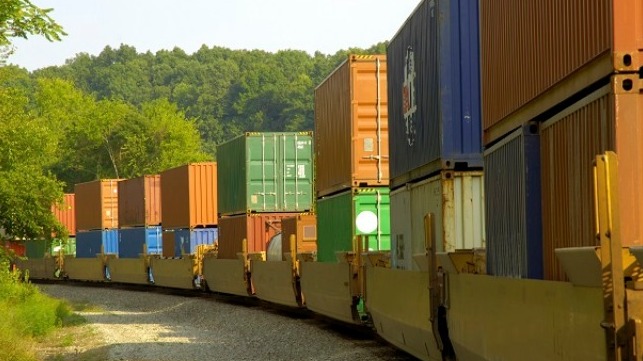Seeking Viability Along the Asian Silk Road Railway

Chinese financing initially helped develop and sustain the operation of the Trans-Asian China-Europe Silk Road railway service. Due to mounting financial pressure, China now reducing the operating subsidy has prompted concern over the railway line’s future viability. The service has however revealed the existence of a sub-market willing to pay higher transportation costs in exchange for reduced transit duration.
Introduction
The redevelopment of the Panama Canal to transit larger container ships sailing mainly between Eastern Asia and east coast of North American was prompted by savings in per container transportation costs for lower priority containers. Per container transportation costs are lower on ships than on railway trains. Eastern customers seeking faster delivery of containers from eastern Asia pay higher per container transportation costs to divert their containers via west coast ports and coast-to-coast railway services. Likewise between China and Europe, a segment of the market willingly paid higher transportation costs in return for faster delivery of containers.
The North American railway system carries containers to at high levels of energy efficiency and at competitive prices, the result of their railway infrastructure having being developed to transit very tall and very long trains. At the present day, extended length trains that often include mid-train locomotives carry double stacked containers coast-to-coast across North America.
India and Australia operate several railway lines that carry double stacked containers. However, height restrictions along the trans-Asian Silk Road railway lines presently prevent operation of double stacked container trains, leaving extended train length with mid-train locomotives as a possible option.
Rail Routes
A trio of main railway lines connects between China and Europe, with the northernmost route passing through Mongolia and Russia to serve container railway traffic from Beijing, Harbin and Shanghai. A second railway line passes south of Mongolia and north of the Aral Sea, attracting traffic from Shanghai, Wuhan and Canton areas. One southern route passes through Iran and includes vessels carrying railway carriages across Lake Van in Eastern Turkey. The alternative southern route involves vessels carrying railway cars across the Caspian Sea to connect to a railway line that passes to the north of Lake Van.
The maritime connections restrict the length of container trains that travel via Iran. With China reducing the operating subsidy, it is uncertain whether a southern railway route without maritime connections across either Lake Van or Caspian Sea would be considered. There is possible potential to consider future operation of extended length trains using additional mid-train locomotives along northern rail routes that pass through Russia, depending on future management decisions by the Russian railway administration. Operation of extended length trains offers the possibility of reducing per train railway right-of-way costs and per container transportation costs.
China – India Railway Cooperation
India has expressed interest in building a railway line from southeastern Iran on the Gulf of Oman to connect to the railway line that extends northwest from Tehran, to the border with Turkey. The possible future volume of combined India and China container train traffic moving between Tehran and Ankara would require international cooperation and financing to investigate cost-effective methods of building a railway line to eliminate the train-on-vessel voyage across Lake Van. If such a project were possible, further investigation could determine possible double-stacked container traffic between Ankara and China, also to southeastern Iran.
The future prospect of combined double-stacked container traffic from India and China being moved by rail between Tehran and Ankara could assure viable operation of that segment of railway line, optimally operating extended length trains with mid-train locomotives. Shorter trains carrying single level containers would operate between Ankara and European destinations. The greater portion of the railway distance would involve double stacked, extended length train operation east of Ankara to assure viable operation without future subsidy. While cooperation amongst governments of Iran, China and India appears possible, regional diplomatic tensions could delay further railway development.
Multimodal Service
Intermodal railway-maritime operation presently occurs at Lake Van in Turkey and at the Caspian Sea, where vessels carry container trains between intermodal terminals on opposite side of the bodies of water. Progress in technology development offers scope to interline railway with wing-in-ground effect transportation where the northern railway route crosses tributaries of the Yenisei River that flows to the Russian Arctic and offering a possible route option. Success of interlined winged ships depends on passage along the Yenisei River via the Arctic to Europe to provide faster delivery of containers at competitive transportation costs.
Conclusions
Given the number of daily container trains that undertake the China – Europe journey, there may presently be scope to examine the possibility of experimenting with a small number of extended length trains that involve additional mid-train locomotives on the rail line across Russia. Discussions with Russian railway officials would be crucial in this regard, as their decision would determine the future viability of China – Europe railway container transportation. There will also be need to investigate potential for operation of extended length trains east of Ankara carrying double stacked containers around Lake Van and the Caspian Sea.
The railways presently carry between one and two percent of the container traffic moving between eastern Asia and Western Europe, with container ships carrying the remainder. Prior to encountering difficulty with their model 737-max-8 passenger aircraft, Boeing researchers produced a computer simulation of a container carrying aircraft that could theoretically carry 28 TEUs in less time than the railways and at many times the transportation cost. A future intermodal railway – winged ship option depends on sufficient clearance along the Yenisei River, obtaining passage along that river as well as faster delivery of containers at competitive costs.
The opinions expressed herein are the author's and not necessarily those of The Maritime Executive.
